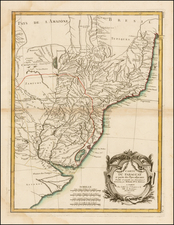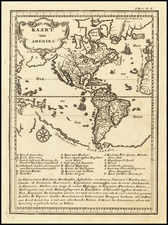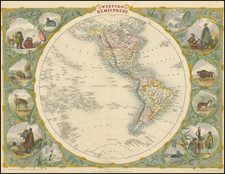Fine example of Aaron Arrowsmith's wall map of America, in four sheets, first published in 1804.
An excellent map of America on the eve of the great era of American exploration by Lewis & Clark, Humbolt, Pike, Long and others.
The map reflects the updates in the Northwest Coast of America to account for the voyages of Cook, Vancouver, Mears, La Perouse and others. Arrowsmith drew from several sources while composing the map, most notably from Mackenzie's 1789 exploration of the Rocky Mountains and the Canadian Northwest, an account of which was subsequently produced in 1798. Mackenzie had been commissioned by the North-West Fur Company and, remarkably, traversed almost 3,000 miles in just 120 days.
The Missions in Upper California are named. The Missouri R. extends fare north of its true source and references Tall & Manders Indian Villages. Columbia R is similarly mis-located. Extensive forts in the Mississippi Valley. A fine depiction of the Americas shortly after the Louisiana Purchase and on the eve of the discovery of the Western parts of North America, Mexico's independence and the century of Revolution in South America.
Lewis & Clark
Above and west of the Mandan Villages, the map incorporates for the first time the reports of Peter Fidler for the Hudson's Bay Company, by including a series of possible river courses to the west, leading to (and prospectively through) the Rocky Mountains. This was the information which showed the prospect of a water route or portage through the Rocky Mountains and to the Pacific. It was this information, along with reports from local Indians encountered on the expedition, which Lewis & Clark relied in choosing their path to the Rocky Mountains.
On the far side of the Rocky Mountains, a section of river called the Great Lake River includes a speculative water course which flows to the Columbia River. This was the route taken by Lewis & Clark which led to their locating a navigable route by water to the Pacific Ocean.
The additions coming from Peter Fidler and the Hudson Bay Company were the result of Fidler's extensive contacts with the indigenous tribes on the eastern slope of the Rocky Mountains and contributed greatly to the geographical knowledge of the region prior to the return of Lewis & Clark.
The present example is the 1808 edition, with the Rathbone Place address replaced with a Soho Square address.
The Arrowsmiths were a cartographic dynasty which operated from the late-eighteenth century to the mid-nineteenth. The family business was founded by Aaron Arrowsmith (1750-1823), who was renowned for carefully prepared and meticulously updated maps, globes, and charts. He created many maps that covered multiple sheets and which were massive in total size. His spare yet exacting style was recognized around the world and mapmakers from other countries, especially the young country of the United States, sought his maps and charts as exemplars for their own work.
Aaron Arrowsmith was born in County Durham in 1750. He came to London for work around 1770, where he found employment as a surveyor for the city’s mapmakers. By 1790, he had set up his own shop which specialized in general charts. Arrowsmith had five premises in his career, most of which were located on or near Soho Square, a neighborhood the led him to rub shoulders with the likes of Joseph Banks, the naturalist, and Matthew Flinders, the hydrographer.
Through his business ties and employment at the Hydrographic Office, Arrowsmith made other important relationships with Alexander Dalrymple, the Hudson’s Bay Company, and others entities. In 1810 he became Hydrographer to the Prince of Wales and, in 1820, Hydrographer to the King.
Aaron Arrowsmith died in 1823, whereby the business and title of Hydrographer to the King passed to his sons, Aaron and Samuel, and, later, his nephew, John. Aaron Jr. (1802-1854) was a founder member of the Royal Geographical Society (RGS) and left the family business in 1832; instead, he enrolled at Oxford to study to become a minister. Samuel (1805-1839) joined Aaron as a partner in the business and they traded together until Aaron left for the ministry. Samuel died at age 34 in 1839; his brother presided over his funeral. The remaining stock and copper plates were bought at auction by John Arrowsmith, their cousin.
John (1790-1873) operated his own independent business after his uncle, Aaron Arrowsmith Sr., died. After 1839, John moved into the Soho premises of his uncle and cousins. John enjoyed considerable recognition in the geography and exploration community. Like Aaron Jr., John was a founder member of the RGS and would serve as its unofficial cartographer for 43 years. Several geographical features in Australia and Canada are named after him. He carried the title Hydrographer to Queen Victoria. He died in 1873 and the majority of his stock was eventually bought by Edward Stanford, who co-founded Stanford’s map shop, which is still open in Covent Garden, London today.









![Suite Du Bresil . . . [2 maps]](https://storage.googleapis.com/raremaps/img/small/103662.jpg)


![[Globe with California as an Island on Allegorical Jesuit Engraving] Saeculum Nostrum in Illuminatione Vultus Tui Psal 89](https://storage.googleapis.com/raremaps/img/small/93732.jpg)

![[ Acapulco and Environs ] Disposition des Vaisseaux de l'Escadre commandee par Mr. Anson croisant, vis a vis d' Acapulco en 1742](https://storage.googleapis.com/raremaps/img/small/98783.jpg)